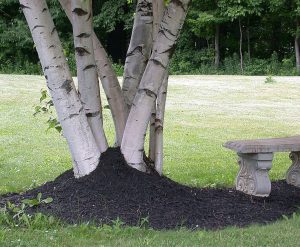As we start to prepare landscape beds for our commercial and residential homeowners in spring, we also begin having conversations about mulch. Mulch has many benefits and should be considered a must-have for every landscape for various reasons.
Benefits of mulch
Mulch offers many benefits, including:
- Giving your landscape beds a fresh, manicured look.
- Protecting and insulating the roots of perennials and shrubs.
- Keeping down weeds in garden areas.
- Keeping moisture in and around plant’s roots, reducing the amount of watering that may be needed.
- Insulates the soil, and in hot weather, keeps the ground cooler for the roots of your plants and shrubs.
Types of mulch
Because we experience varying seasons and temperatures in the Midwest, mulch added to your landscape beds the season before has probably disintegrated somewhat or, at the least, looks a bit dull. It could use a refresh, and spring is the time to do just that.
Typically, we install organic mulch like wood chips and bark, which may consist of hard or soft wood. We like it because it’s an environmentally-friendly way to recycle trees that have been cut down and put them to good use.
Installing mulch

Properly installed mulch is applied to the bed to maintain a two-inch thick layer. However, mulch should never be piled thick up the trunk when mulching around trees and shrubs. We call this “volcano” mulching. It causes issues with the tree or shrub, holding in moisture on the trunk, which can cause rotting and disease. Instead, mulch should be pulled away from the trunk approximately 6-12 inches to keep it from resting on the plant.
If you’re interested in having mulch installed or have questions, please feel free to contact us.

